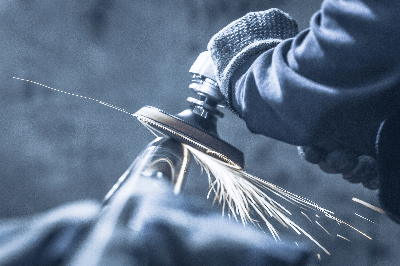What Is a Grinder?

A grinder is a processing machine used primarily for surface finishing and other polishing processes.
Various polishing methods exist, requiring appropriate grinding wheels and abrasives. Depending on the grinder, the workpiece may be placed close to a high-speed rotating grinding wheel. Care must be taken to avoid burns from sparks or being caught in the machine during operation.
Uses of Grinders
Grinders are mainly used to finish the surface of parts, but they can also be used for rough polishing to remove burrs. In addition to surface finishing, polishing is also used to finish the inside of cylindrical parts. This is because the smoothness of the polished surface improves the sliding properties of the parts.
Polishing is also used for cylinders, rail sliders, and many other parts that perform sliding movements. Recently, there are many desktop size grinders available, which are increasingly being used for polishing silver jewelry and removing burrs from plastic models at home, as well as in factories.
Principle of Grinders
Abrasive grains contained in grinding wheels and abrasives used for polishing exert an effect similar to that of small blades, gradually shaving off the workpiece. The most typical type of polishing is “grinding wheel polishing,” in which the workpiece is polished by placing it against a grinding wheel rotating at high speed.
Although this is a very simple polishing method, it requires a great deal of skill. The finish varies depending on the small differences in the force and angle at which the workpiece is pressed against the grinding wheel. As processing proceeds, the grinding wheel itself also wears out and becomes worn out, so it must be replaced with a new grinding wheel at the appropriate time while monitoring the amount of wear and tear on the grinding wheel. In principle, filing with sandpaper is similar, but more efficient.
A similar procedure exists for buffing, in which a “buff” made of soft material such as cotton or felt is used instead of a whetstone for polishing. It is more effective in smoothing surfaces than whetstone polishing and is used for mirror finishing. On the other hand, polishing takes time, so it is not suitable for applications that involve reducing the thickness of the workpiece.
Since grinders work by moving the workpiece close to an object rotating at high speed, care must be taken to avoid injury during operation. In particular, when polishing with gloves, there is a possibility that frayed threads could get caught in the high-speed rotating parts. Even with a small grinder, the force of entrapment is so great that it is dangerous and can lead to serious injury. Also, depending on the material of the workpiece, sparks may be generated upon contact with the grinding wheel, so care must be taken to avoid burns.
Other Information on Grinders
1. Stainless Steel Surface Treatment Using an Electrolytic Grinder
Stainless steel is a metallic material with rust and corrosion resistance and heat resistance due to the several-nanometer-thick passivation film formed on its surface by bonding with oxygen in the atmosphere. However, if the proper surface condition is not maintained due to machining, surface finishing, transportation, or storage, the passive film will not form evenly, resulting in defective products.
Electropolishing is a process that aims to remove impurities and roughness from the surface of stainless steel cleanly and form a passivation film with high properties. In a stainless steel electropolisher, the surface is electrochemically dissolved and cleaned in microns by passing a direct current through the stainless steel, the object to be polished, as an anode in an electropolishing solution.
Rough surface convexities are preferentially dissolved to reduce surface roughness, and defects that are difficult to remove by normal polishing, such as burr coverings and voids underneath, caused by polishing or machining, can be smoothed out. It is also highly productive because the processing method is simple, and depending on the size of the electrolytic solution tank, large amounts of polishing can be performed.
Passive film has excellent corrosion resistance and heat resistance, but its thickness is thin and weak at only a few nanometers, so the smoother the stainless steel surface, the more uniform and highly adherent the film will be. Electropolishing is an important process to maximize the characteristics of stainless steel.
2. Electrolytic Combined Grinder
Electrolytic combined polishing, which combines physical polishing with abrasives, is effective when an even smoother surface than electropolishing is required. A rotating polishing disc is used as a cathode, and the surface of the workpiece is subjected to electrolytic solution and electric current while it is being moved and polished.
The passive film on the convex surface is mechanically removed, and the metal is eluted from it, resulting in smoother polishing than when electrolytic and mechanical polishing are performed independently. The feature of this process is that it can achieve a roughness on the order of nanometers.
Because it can polish not only flat surfaces but also curved surfaces such as pipes, it is widely used for semiconductor manufacturing-related parts, piping, valves, and medical equipment that require precision and durability.